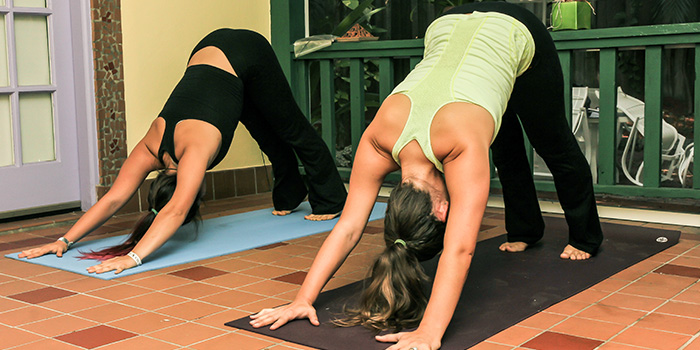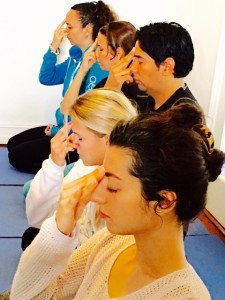
A Sample Pranayama Plan for Asthma
by Azita Djahanshahi
The process of working with asthma patients has to be developed gently and systematically based on assessment findings through ongoing observation. For the purpose of devising the most effective individualized program, the yoga therapy practitioner must carefully discern suitable yoga methods especially with regards to pranayama techniques as to skillfully support the client manage symptoms, improve function of the lungs, and enhance the efficiency of the respiratory muscles. The main part of the regimen would be exclusively regulating the breathing pattern to mitigate the likelihood of hyperventilation and other dysfunctional breathing patterns associated with asthma including chest breathing, mouth breathing, breath retention particularly after the inhalation phase, paradoxical (reverse) breathing.
The respiratory support of yoga can provide a viable therapeutic resource for these individuals to correct these existing breathing dysfunctions and progressively replace them with the healthiest ones. One of the most valuable benefits the practitioners can receive from breathing regulation practices that yoga has to offer is the awareness of using their breath as a powerful tool that they have with them wherever they are, to better manage or avert an undesirable event. Because through restoration of efficient breathing, the emotions associated with asthma begin to slowly dissipate and consequently the client gains a sense of control and self-assurance.
With asthma, expiration presents more difficulty relative to inspiration. Due to closing of the airways during exhalation, the residual volume—the amount of remaining air after normal exhalation—drastically increases. As a result, there remains less free space available for fresh incoming air to enter in and that will still be mixed with greater volume of oxygen-poor (stale) air. Hence, the expiratory breathing practices are considered to be greatly therapeutic to these individuals and should be a regular part of an asthma therapy plan.
The Pranayama Practice Plan
1. Supported Deep Relaxation Pose (Savasana), 5–10 minutes. Begin relaxing and effortlessly attending to the normal pattern of breathing so as to connect to perceptible sensational experiences.
2. Diaphragmatic Breathing in Savasana, 5–7 minutes. Keep one hand lightly on the abdomen and the other on lower ribs (middle chest; the thoracic region). Keeping the abdomen as relaxed as possible, inhale slowly through the nose, smoothly and as fully as possible without strain. As you do so, feel the hand on the abdomen moving upwards as the abdomen expands. There should be little or no movement of the fingers resting on the chest. Exhale through the nose slowly, smoothly and as completely as you can, again without force. As you do so, feel your hand moving downwards as the abdomen contracts. Repeat for another 5–7 minutes, or as long as you can in smooth succession. Then relax your arms and breathe regularly. The diaphragm executes about 80 percent of the process of respiration. Poor function of the diaphragm in breathing is most probably at the root of a large number of respiratory disorders including asthma. By learning and practicing diaphragmatic breathing regularly, those with astham will:
- Be able to use their diaphragm more efficiently
- Benefit the increase in tidal volume (the volume of air inspired and expired in one normal respiratory cycle) as well as that of the alveolar ventilation
- Lessen the use of the accessory breathing muscles, such as those of the neck and shoulders
- Ease the work of breathing, by establishing a natural, efficient, and even pattern of breath.
3. Gentle Forward Fold, resting forehead on a chair, 1–2 minutes
4. Breathing in Sukhasana Against the Wall or Supported Reclined Sukhasana, 5–7 minutes. Restfully observe the normal pattern of your breathing to differentiate the sensational experiences (movement, rate, depth) associated with breathing in an upright posture compare to a supine position.
Introduce 2:2 nasal breathing (2-second inhalation and 2-second exhalation; equal breathing), with ease for a few cycles. Rest, then practice 2:2:1 nasal breathing (pausing after the exhalation). Based on the level of comfort, introduce a small resting pause after the exhalation in 2:2 breathing, causing the exhale to flow more smoothly and naturally into the subsequent inhale
Caution: Until the client get accustomed to even breathing, I don’t ask them to lengthen the exhalation phase, as this can potentially create an undesired disruption during breathing. After a few sessions, or based on their degree of readiness, I slowly ask them to work up to making the exhalation longer (1:2 breathing), as long as they are not jerking, struggling, or making noise. And, if applicable, introducing an additional small pause after inhalation as well (2:1:2:1 > 2:2:2:2).
The 1:2 nasal breathing, taking twice as long to exhale as to inhale, allows the airways to stay dilated longer and consequently decreases the residual volume. It also facilitates the release of the same volume of breathed air over a longer period of time, which can gradually raise the carbon dioxide levels and open up the cerebral circulation. The slowing down effect of exhalation, as well, reduces the respiratory rate and therefore the heart rate, lowers blood pressure, and alleviates the sense of anxiety and panic that accompanies labored breathing (dyspnea).
5. Supported Bridge (Setu Bandha Sarvangasana), 1–2 minutes
6. Breathing Diaphragmatically in Bridge with Palms Resting on the Region of Solar Plexus (Diaphragm), 3–5 minutes.
Positioned mildly inverted in Bridge, the diaphragm moves with gravity on the exhalation, not against it as it does when one is upright. This position, also, passively strengthens the diaphragm since it moves against gravity on the inhalation. Effortless slow nasal breathing, smoothly decelerate rate of inhale and merge it to exhale and smoothly decelerate rate of exhale and merge it to inhale.
7. Abdominal Breathing (Diaphragmatic Breathing) in Supported Savasana with palms resting on the abdomen, 5 minutes.
Return back to the starting point to observe finer improvements in breathing and circulation (resulting from the up-and-down motion of diaphragm), and progressively cultivate more awareness on the regions of diaphragm and abdominals to resolve chronic thoracic breathing > rest and breathe feelings of healing energy into your lungs.
Tip: As the client progressively exhibits great enhancements in terms of rate and pattern of breathing, the bhramari breath in a mild manner can be later introduced to the therapy plan. The individual should be able to create a sustainable rhythm to his/her breath as well as to breathe in a more relaxed manner with much fuller (longer) and smoother inhalations and naturally extended exhalations. The therapist needs to sharpen his/her ability to note any finer changes in breathing pattern and musculoskeletal tension (i.e. old patterns of tension in the solar plexus, neck, etc), and to stay fully receptive to the client’s moment-to-moment stand in order to adapt appropriate goals or alter the lesson plans accordingly.
After having observed a consistent advancement in the client’s breathing performance and his/her ability to deliberately release tension, the therapist might initially add a milder ujjayi (to avoid over constriction of the throat and contributing to any breathing problems) to the inhalation and later in weeks, to the exhalation as well without forcing it and making sure that the exhalations and inhalations stay relatively equal. Since in asthma, the cooled air can trigger bronchoconstriction causing the impediment of airflow, hence refraining from practicing some pranayama techniques such as shitali or sitkari in which the inhalation is through the mouth, has been advised. Likewise, rapid strong breathing techniques as in kapalabhati and bhastrika, will not be advisable and considered not therapeutic specifically in early stages or even years of working with this population due to the complexity of symptoms.
Azita Djahanshahi, RYT-200, a Clinical Yoga Therapy candidate at AUM, discovered yoga shortly after she moved from her home country, Iran, to Miami in 2009. Fascinated by the way the practice lightened her burden of sadness and helped her to carry out a more graceful transition to her new, unfamiliar life, she was propelled to walk further in the path. In 2013, she completed Prana Yoga’s 200-hour Yoga Teacher Training program and is also a certified restorative yoga teacher. In future, Azita hopes to help create partnerships with health-care professionals to forge an integrative therapy plan for a broad array of health dysfunctions.
References:
Coulter, H. David. (2010). Anatomy of Hatha Yoga: A manual for Students, Teachers, and Practitioners. Albany, CA: Body & Breath.
McCall, Timothy, M. D. (2007). Yoga as Medicine: The Yogic Prescription for Health and Healing: A Yoga Journal Book. New York, NY: Bantam Books.
Frazee, Crystal, PT, RYT. (2016). Aum Home Shala Yoga Therapy Level II Program Respiratory Module.


